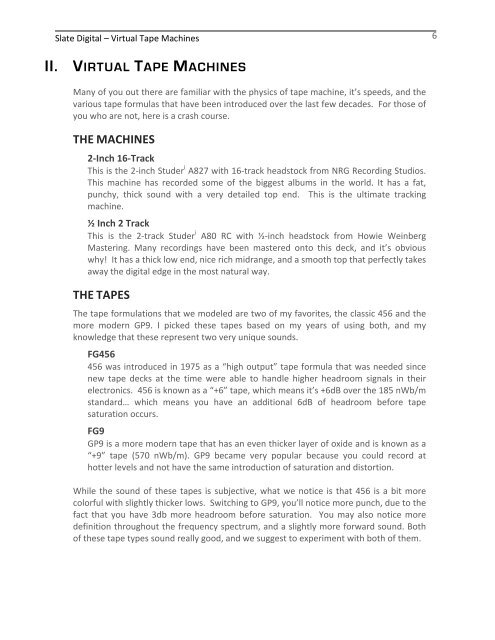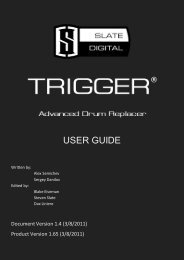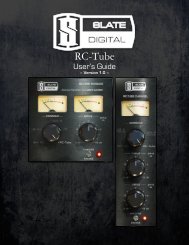iii. virtual tape machines - Slate Digital
iii. virtual tape machines - Slate Digital
iii. virtual tape machines - Slate Digital
Create successful ePaper yourself
Turn your PDF publications into a flip-book with our unique Google optimized e-Paper software.
<strong>Slate</strong> <strong>Digital</strong> – Virtual Tape Machines<br />
II. VIRTUAL TAPE MACHINES<br />
Many of you out there are familiar with the physics of <strong>tape</strong> machine, it’s speeds, and the<br />
various <strong>tape</strong> formulas that have been introduced over the last few decades. For those of<br />
you who are not, here is a crash course.<br />
THE MACHINES<br />
2-‐Inch 16-‐Track<br />
This is the 2-‐inch Studer i A827 with 16-‐track headstock from NRG Recording Studios.<br />
This machine has recorded some of the biggest albums in the world. It has a fat,<br />
punchy, thick sound with a very detailed top end. This is the ultimate tracking<br />
machine.<br />
½ Inch 2 Track<br />
This is the 2-‐track Studer i A80 RC with ½-‐inch headstock from Howie Weinberg<br />
Mastering. Many recordings have been mastered onto this deck, and it’s obvious<br />
why! It has a thick low end, nice rich midrange, and a smooth top that perfectly takes<br />
away the digital edge in the most natural way.<br />
THE TAPES<br />
The <strong>tape</strong> formulations that we modeled are two of my favorites, the classic 456 and the<br />
more modern GP9. I picked these <strong>tape</strong>s based on my years of using both, and my<br />
knowledge that these represent two very unique sounds.<br />
FG456<br />
456 was introduced in 1975 as a “high output” <strong>tape</strong> formula that was needed since<br />
new <strong>tape</strong> decks at the time were able to handle higher headroom signals in their<br />
electronics. 456 is known as a “+6” <strong>tape</strong>, which means it’s +6dB over the 185 nWb/m<br />
standard… which means you have an additional 6dB of headroom before <strong>tape</strong><br />
saturation occurs.<br />
FG9<br />
GP9 is a more modern <strong>tape</strong> that has an even thicker layer of oxide and is known as a<br />
“+9” <strong>tape</strong> (570 nWb/m). GP9 became very popular because you could record at<br />
hotter levels and not have the same introduction of saturation and distortion.<br />
While the sound of these <strong>tape</strong>s is subjective, what we notice is that 456 is a bit more<br />
colorful with slightly thicker lows. Switching to GP9, you’ll notice more punch, due to the<br />
fact that you have 3db more headroom before saturation. You may also notice more<br />
definition throughout the frequency spectrum, and a slightly more forward sound. Both<br />
of these <strong>tape</strong> types sound really good, and we suggest to experiment with both of them.<br />
6




